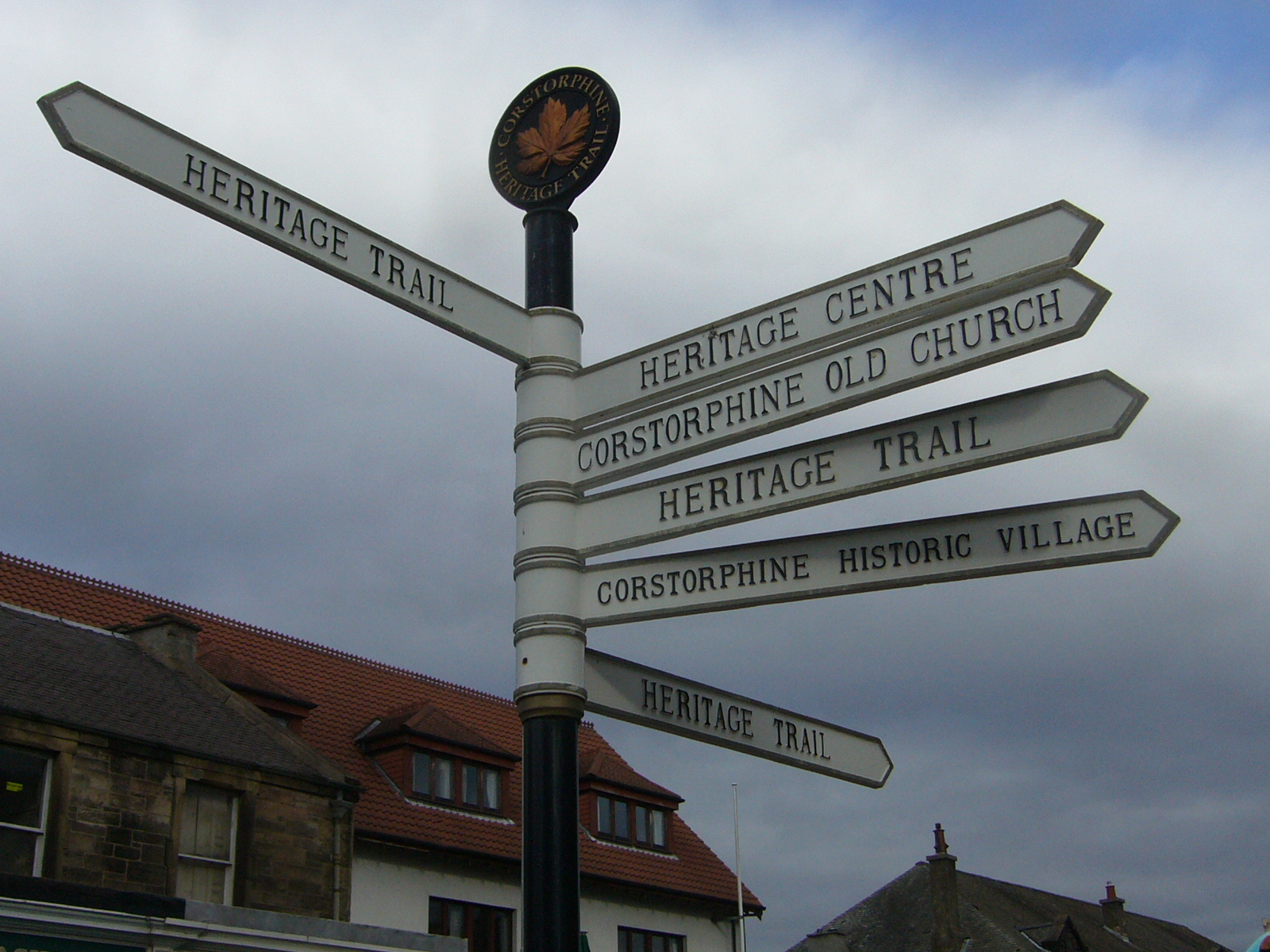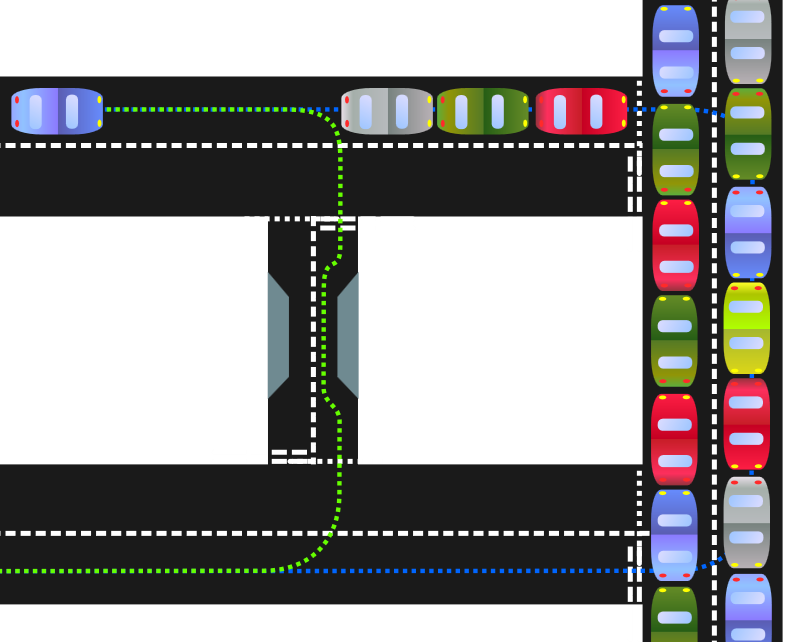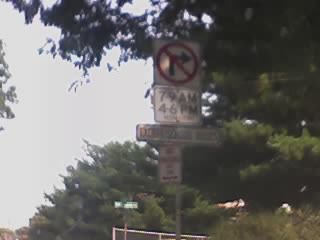Measure type: Directing traffic flows
Directing flows of people is a form of a traffic management measure that can mitigate the likelihood of a security event (preventive direction of flows of people) or reduce the impact of a security event(reactive direction of flows of people).
Description
Directing traffic flows is a traffic management measure of directing the traffic in a preferred way. Whereas this usually is done from a traffic management perspective to improve throughput of a road network[1], it can also be applied to increase security. In this case, the measure is usually intended to separate potential offenders from locations or circumstances where they might do harm. Examples of direction of traffic flows for security reasons include building barriers for vehicles, to provide safe transportation to and from entertainment centres across high-risk areas, to ensure a car-free zone around a building as a protection against car bombs or to separate pedestrians from motorcycles to prevent snatch theft. As a measure to reduce the consequences of an incident, crowd control at large events or transportation hubs can prevent the outbreak of disorder or riots[2][3].
A traffic flow measure can be directed at all traffic, or only certain modes of transportation. For example, a water obstacle would be effective against all road transportation, a gravel pit would stop rolling vehicles, but not pedestrians, and an average fence would stop pedestrians, but not ramming vehicles.
Examples
Examples of directing traffic flow measures are:
By physical route guidance
- Signposts
- Traffic signs
- Route guidance with Dynamic Route Information Panels (DRIP)
- Route guidance and traffic information provision via navigation systems
By hard and soft barriers blocking unwanted traffic flows
- Elevation to stop rolling vehicles or discourage pedestrians
- Water or gravel barrier
- Green barrier
- Bollards
- Traffic slowing measures, such as speed ramps, discouraging rat running
By psychological barriers or route guidance
- By indicating wanted pathways by lighting
- By discouraging unwanted pathways by making them seem dead-end
- By intentionally designing one route to be more attractive than another (for example intentionally making an alternative road look narrow and obscure for cars, or by planning popular attractions for tourists to be along a defined route)
By providing natural, direct routes
- Designing pathways directly and obviously to main points of interest equipped with all required security features
- Increasing traffic flows in desired main through routes in a city by facilitating shorter travel times with green waves and thereby reducing traffic in less desired areas.
By regulation
- One-way streets
- Prohibited places
- Restricted access (for, for example, certain kinds of traffic or at specific times)
Effectiveness
Security issues where this measure can be effective and influenced by the urban planner, are:
| Financial gain | Boredom or compulsive behaviour | Impulse | Conflict in beliefs |
|---|---|---|---|
| Burglary | Physical assault | Destruction by riots |
Mass killing |
| Ram-raiding | Sexual assault | Destruction of property by fanatics | |
| Pickpocketing | Vandalism | ||
| Robbery | Graffiti | ||
| Raid | Antisocial Behaviour | ||
| Vehicle theft |
Considerations
General considerations
For measures on traffic flows to be effective, the measures should match the docility of the targeted traffic flows. For instance, an average fence can be very effective against the average pedestrian, but less effective against an motivated vandal and hardly effective at all against a fanatic terrorist. In an urban context, the realisation form of a measure should conform to the targeted public, threat level and surroundings: high, unfriendly walls will be inappropriate in a shopping area and low, open fences are inappropriate for high-risk objects.
Urban planning considerations
Measures to direct traffic flows provide a useful mechanism for reducing the opportunity for criminal activity.
Where possible, access to vulnerable areas (such as residential estates) should be restricted to as few routes as possible and should be designed to serve the needs of the development rather than any through traffic. Unrestricted opportunities to access, familiarise, offend and escape should be avoided. However, the intent is to disallow unintended behaviour and not to inconvenience legitimate users. Some practical considerations in restriction of traffic flows in designs is given in the US document 'Site Security Design Guide'[4].
Consideration should be given toward the needs and separation between different traffic types, if applicable, such as pedestrian and motor traffic. Desired routes for each mode should be clearly delineated and natural surveillance should play a role in facilitating voluntary compliance of such rules.
However any measure to direct traffic flows must take accessibility into consideration, particularly for emergency vehicles and evacuations.
Safety/security considerations
When directing traffic flows, its impact on traffic safety should always be considered. Another safety aspect of limiting mobility is the issue of evacuation management, as the ability to evacuate quickly in case of emergencies can be an important element in providing safety.
Social considerations
The measure of directing traffic flows needs to consider general aspects of the designing out approach and its critics. Another important social aspect is the responsiveness of this measure to citizens' felt security needs. Measures such as directing traffic flows will only be responsive if they are based on identification of citizens' self-perceptions of vulnerabilities and security gaps. Aditionally, it must not be forgotten that resilience-enhancing measures are no substitute for continuously informing citizens' with risks, how to assess risks, and how to prepare for realisation of risks.[5]
Practical addressing of social aspects and aspects of security culture in security measures such as directing traffic flows can best be accomplished by appropriately involving citizens, based on a set of introduced methods of citizen participation as compiled by VITRUV. Ideally, planning for the measure of directing traffic flows should include usability tests in relevant social contexts. The sociospatial perspective is an example of an approach to do so.
Economic considerations
Transportation infrastructure is a crucial component of every economy as it enables the transport of resources from one location to the other. Roads, public transportation, hubs, etc., however, can also be (ab)used by criminals and terrorists for their activities, or be targeted themselves. Both result in negative economic effects for society, ranging from direct material damage to indirect economic effects as a result of a limitation of mobility (e.g. when transportation hubs are being damaged). Directing traffic flows (see the case example below) aims to prevent the occurrence of security threats and/or limit the negative effects of it (including the economic effects). Nevertheless, security measures do not just result in benefits, but also imply cost (the economic effects of security measures).
The above mentioned cost of traffic flow management measures contain the relatively straightforward direct expenditures on capital equipment and operational cost (both temporary and permanent), such as the investment in bollards, traffic signs and water barriers. On top of that, traffic flow measures generate various types of indirect economic effects that will have an impact on the economy as a whole. The reason behind this is that, although managed traffic flows will result in a more robust mobility of goods and persons, one has to bear in mind that mobility (as a whole) will be limited as well. Traffic rules such as speed limits, for instance, aim to improve safety and the robustness of the road network, but at the same time increase travel time for road users (since they cannot drive as fast as wished for in all cases). Indirectly, this limited accessibility could lead to negative economic effects as a result of the less efficient transportation of goods, skills and persons. These negative impacts will reduce the functioning of the markets in the local economy, reduce the functioning of labour markets, and attribute to a decrease in scale and agglomeration advances (due to a decreased market size).
Case example: Effectiveness of traffic management:
"The application of horizontal deflections (e.g. bends and chicanes) that are enforced by VSBs [Vehicle Security Barriers] will limit hostile vehicle approach speed thus reducing the effectiveness of a penetrative vehicle impact. In turn, this can reduce the requirements and associated cost of countermeasures and provide opportunities to deploy discreetly integrated protection. Although effective for road-safety engineering purposes, traffic calming using vertical deflections (e.g. road humps) is not an effective security measure as it provides a negligible speed reduction against a determined vehicle-born attack."(CPNI, 2011)[6]. Hence, VSBs are making more sense from an economic point of view than, for instance, traffic calming measures such as road bumps. The reason behind this is that VSBs do not just reduce the risk of a penetrative vehicle impact, but also reduce investments in other security measures and on top of that enables discreet protection (generating economic benefits for the local economy).
Whether or not traffic flow measures make sense from an economic point of view depends on many factors. Involved urban planners should start to ask themselves which security issue has to be resolved, and if traffic flow measures are the right instrument for this particular issue. In addition, the urban planner should research alternative measures that might be more effective (in terms of a better benefit-cost ratio), and involve the direct and indirect effects on stakeholders, including the criminals and terrorists that might alter their behaviour (in economic terms, the economics of crime/terrorism). These steps are summarised in this step by step flow chart of an economic assessment. Economic tools can help decision makers to answer these questions and to prevent wasteful expenditures on security (of course in collaboration with insights from criminology, sociology, etc.).
Mobility considerations
An essential aspect for effectively closing or discouraging pathways is that an alternative route should be clearly available.
A good road design should be such that most traffic chooses the routes as preferred by the road manager to accommodate the largest traffic flows, and not the less preferred routes such as small routes within city centres. For example, there should be clear access routes to larger ring roads and motorways with sufficient capacity leading out of urban districts.
Information about alternative routes can be given to the road users with a Dynamic Information Panel (DRIP). Usually a few alternative routes are given with their actual travel times. People are thus encouraged to choose the route with the lowest travel time, which helps to reduce congestion on the alternative route. See also traffic management.
Traffic flows can also be directed by giving traffic information via navigation systems or smart phone applications. An example of a recent development with smart phone applications is an app for pedestrians during large events that indicates the crowdedness of certain areas, based on localization of other app users or blue tooth detection. This app was launched for the Dutch coronation event, though at the latest moment crowdedness indicator functionality was withdrawn out of fear that so much bandwidth would be used that emergency services couldn't communicate anymore. Another example is a mobile phone app [7] that gives the user specific travel advice and, at the same time, provides information from the car or public transport to highways authorities and traffic managers. The app 'FileAlarm' is linked to the user’s smartphone agenda. In this way the app sees that you have to travel to an appointment, checks the route conditions at that moment and alerts the user when to depart. This also generates a lot of information about the travel patterns of people and thus helps the highways authorities to more specifically adjust capacity and provide individual or groups of travellers with customised travel advice. It also contains information on the number of available parking spaces and guides the drivers to a parking close to their destination. This prevents long waiting queues and chaos at the entrances of parking garages. Another way to do this is with Parking Guidance Information signs, showing the number of free parking spaces in several parking garages.
Ethics considerations
Directing traffic flows may only decrease risk to high-status buildings such as embassies. This can raise ethics aspects related to distributive justice since the measure can carry the risk of reifying uneven distribution of security in society: It may contribute to selective delivery of security, contributing to making only some groups of citizens more secure. Another aspect is the interaction between built infrastructures and human rights (e.g. rights to access and supply). This illustrates the need to provide norms and standards beyond frameworks for built infrastructure.
In general, pinpointing specific ethics aspects in resilience-enhancing measures needs to consider, among other things, citizen security cultures and citizens' personal concerns. There are no ethics considerations that can be planned or implemented without prior identification and addressing of citizens' perceptions. To support this, VITRUV offers a commented list of methods to determine ethics aspects in relevant urban planning.
Legal considerations
Legal considerations when considering access control measures are:
- City development plan / functional zoning - Measures for directing traffic flows can impose on integrated land use and transport planning strategies
- Development management standards - Measures for directing traffic flows may change connectivity and permeability or site development standards
- Traffic impact requirement / road construction - Measures for directing traffic flows may influence traffic flows in a wider area
- Safety - Measures for directing traffic flows may change for example the emergency evacuation situation of an area
- Building codes / building regulations - Measures for directing traffic flows may change for example accessibility for people with disabilities or impose on minimum widths for pedestrian or vehicular routes
- Appearance - Measures for directing traffic flows may change the appearance of an object
- Cultural heritage preservation - Measures for directing traffic flows may impose on cultural heritage rules
Footnotes and references
- ↑ For example, when a certain route is congested, the traffic can be guided to an alternative route with a dynamic route information panel (DRIP). The measure is also applied to increase safety, such as for instance to prevent flows of traffic from colliding, manage crowds or to support evacuation management in case of emergencies.
- ↑ http://en.wikipedia.org/wiki/Crowd_control
- ↑ Pedestrian simulation can help model the flow of pedestrians. The modelling of the individual movement of pedestrians results in a description of macroscopic pedestrian flow and allows e.g. the evaluation of escape routes, the design of pedestrian facilities and the study of more theoretical questions. A typical example of a pedestrian simulation model is STEPS
- ↑ http://wbdg.org/ccb/GSAMAN/site_security_dg.pdf
- ↑ Dennis S. Mileti/John H. Sorensen: Communication of Emergency Public Warnings. A Social Science Perspective and State-of-the-Art Assessment. Oak Ridge, TN: Oak Ridge National Laboratory, U.S. Department of Energy, 1990.
- ↑ Centre for the Protection of National Infrastructure (2011): Integrated Security; A Public Realm Design Guide for Hostile Vehicle Mitigation.
- ↑ http://www.tno.nl/content.cfm?context=overtno&content=nieuwsbericht&laag1=37&laag2=69&item_id=2012-03-22%2011:19:55.0&Taal=2





